Chapter 7 - Genetic Transfer and Mapping in Bacteria
1/32
Earn XP
Name | Mastery | Learn | Test | Matching | Spaced |
|---|
No study sessions yet.
33 Terms
Genetic Transfer
A process in which a segment of bacterial DNA is transferred from one bacterium to another. This is used in place of genetic crosses for bacteria since they reproduce asexually via binary fission.
Bacteriophages
Also called phages, these are viruses that infect bacteria. They contain their own genetic material that governs their traits. This genetic material is surrounded by a protein coat. Depending on the organism, it can follow two different cycles: lytic or lysogenic.
Bacteria / strains / haploid
Fill in the blank…
Like eukaryotes, ( ) often possess allelic differences that affect their cellular traits. However, these allelic differences (like sensitivities to antibiotics) are between different ( ) because these organisms are usually ( ).
Conjugation
The transfer of genetic material from one bacterium to another that occurs through direct physical contact. This enhances genetic diversity in families.
In this process, the donor cells transfers a strand of DNA to the recipient. Often, this occurs when a circular segment of DNA known as a plasmid is transferred to the recipient cell.
Many, not all, species conjugate. However, only certain strains can serve as donor cells.
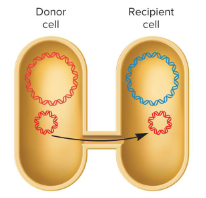
Transduction
The transfer of genetic material from one bacterium to another that occurs via bacteriophages. This enhances genetic diversity in bacteria.
When a bacteriophage infects a donor cell, it incorporates a fragment of bacterial chromosomal DNA into a newly made phage particle. This phage then transfers this fragment of DNA to a recipient cell, which incorporates the DNA into its chromosome by recombination.
Ex) Donor cell is his+. This gene is on a chromosome fragment that is packaged into a phage particle when the phage infects it and digests the host DNA. The phage DNA with the his+ gene infects a recipient cell, which becomes a recombinant bacterium that is his+.

Transformation
The transfer of genetic material from one bacterium to another that involves uptake from the environment. This enhances genetic diversity in bacteria.
When a bacterial cell dies, it releases a fragment of its DNA into the environment. This DNA fragment is taken up by a recipient cell, which incorporates the DNA into its chromosome by recombination.
Discovered by Griffith during his studies on strains of S.pneumoniae.

Auxotrophs / phototrophs / transferred
Fill in the blank…
Lederberg and Tatum were studying strains of E.coli that had different nutritional growth requirements. ( ) can’t synthesize a particular nutrient and thus need it in their growth medium. ( ) make all their nutrients from components in their growth medium.
One strain could synthesize three amino acids but needed biotin and methionine for growth. Another strain was the opposite (could produce biotin and methionine but not the other three amino acids).
To grow on a plate lacking all five nutrients, the bacteria needed to have genomes positive for the enzymes needed to produce these nutrients. Individually, the two strains didn’t grow on the plates. When mixed and plated together, bacterial growth was observed. Thus, Tatum and Lederberg proposed that genetic material was ( ) between the two strains, but the way in which this occurred could not be distinguished (i.e. which strain transferred what).

U-tube / No / touch / conjugation
Fill in the blank…
Davis conducted his experiment with a ( ), which contains a filter at the bottom with pores that are large enough for passage of genetic material but small enough to prevent passage of bacterial cells. He added the two strains to opposite sides of the filter and promoted movement of liquid with suction.
He then plated the two strains on growth media that selected for the all positive genotypes.
Did anything grow? ( ). As such, Davis concluded that bacteria must ( ) or undergo ( ) to transfer genetic material.

F Factor
A fertility factor. It is a small circular piece of DNA containing genes that play a role in the transfer of DNA. Strains containing this are F+ while those lacking it are F-. These genes are named either tra or trb followed by a capital letter.

Sex (F) pili / conjugation bridge
Fill in the blank…
The first step in conjugation is the contact between donor and recipient cells. This is mediated by ( ) made only by F+ strains. These serve as attachment sites for the F- bacteria. Once contact is made, these structures shorten, the two cells are drawn closer together, and a ( ) is formed between the two cells. This stimulates the donor cell to begin the transfer process.
1) Relaxosome recognizes origin of transfer and makes a cut in the F-factor DNA.
2) After cutting, accessory proteins of the relaxosome are released.
3) Relaxase remains bound to the end of the T-DNA and is recognized by the coupling factor, which pushes it towards the exporter
4) Exporter (a complex of 10 to 15 proteins encoded by the F factor spanning the inner and outer membranes) pumps DNA/relaxase into the recipient cell via the conjugation bridge
5) Once in the recipient cell, the F-factor DNA is replicated to become double-stranded and relaxase joins the ends of the single-stranded DNA. The F-factor DNA is also replicated to become double-stranded in the donor cell.
What are the steps for the mechanism of transfer in conjugation?
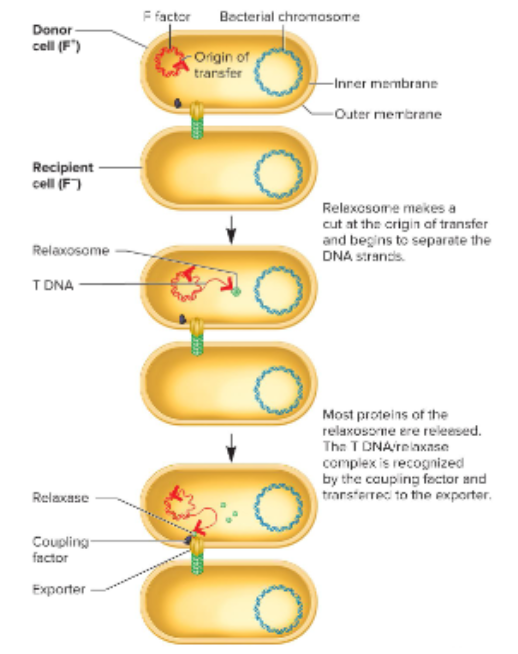
An F- cell in converted to F+ while the F+ donor cell remains unchanged
What is/are the result(s) of conjugation in bacteria?
Plasmid
A general term used to describe extra-chromosomal DNA. Most are circular, though some are linear. They present in many bacteria and a few eukaryotic species. They contain their own replication of origin, replicate independent of the bacterial chromosome, and can exist in single copies or numerous copies in a cell.
They are not usually required for survival but they provide growth advantages to the bacteria.
Fertility Plasmids
Plasmids that allow for conjugation.
Resistance Plasmids
Plasmids known as R factors that contain genes conferring resistance to antibiotics.
Degradative Plasmids
Plasmids that carry genes allowing digestion of unusual substances.
Col-Plasmids
Plasmids that contain genes which kill other bacteria.
Virulence Plasmids
Plasmids that carry genes that turn bacteria into pathogenic strains.
Hfr Strains
Strains of E.coli discovered by Cavalli-Sforza that were very efficient at transferring chromosomal genes. This stands for “high frequency of recombination”.
They were derived from F+ strains in that they occurred when an F factor integrated into the actual bacterial chromosome.

F’ Factors
F factors that were once integrated into a bacterial chromosome but were excised in an imprecise fashion and may carry genes that were once found in the bacterial chromosome.
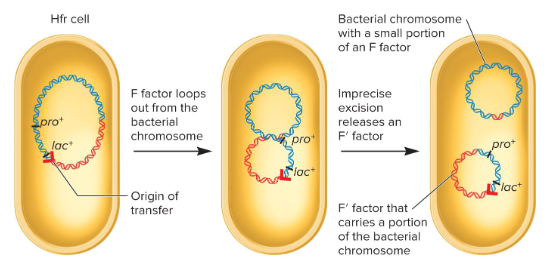
Hfr / portion / recombine
Fill in the blank…
Hayes showed that conjugation between an Hfr and F- strain involves the transfer of a portion of the ( ) bacterial chromosome. The origin of transfer of the integrated F factor determines the starting point and direction of the transfer process. When the DNA is cut here, it becomes the starting point for the transfer of the Hfr chromosome to the F- cell. Then, a strand of bacterial DNA begins to enter the recipient cell in a linear manner.
It takes upwards of two hours for the entire Hfr chromosome to be passed to the F- cell, but most conjugations don’t last that long. Only a ( ) of the Hfr chromosome gets into the F- cell and this material can ( ) with the homologous region of the chromosome of the recipient cell.
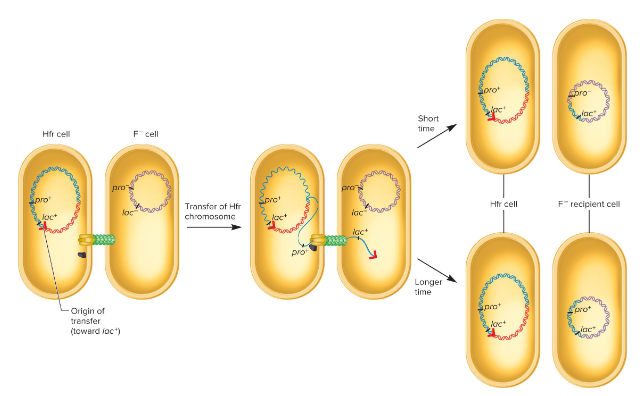
Interrupted Conjugation
This technique was developed by Wollman and Jacob. The rationale for this technique is as follows…
The time it takes genes to enter the recipient cell is directly related to their order along the bacterial chromosome. Thus, interrupting conjugations at different times leads to various lengths being transferred. The order of genes along the chromosome can be deducted by determining the genes transferred during short conjugations versus those transferred during long conjugations.
This technique has been used to map more than 1,000 genes on the E.coli chromosome. The E.coli genetic map is 100 minutes long and its starting point, 0 minutes, is assigned near the thrA gene. The units (minutes) refer to the relative time it takes for genes to enter an F- recipient during a conjugation experiment.
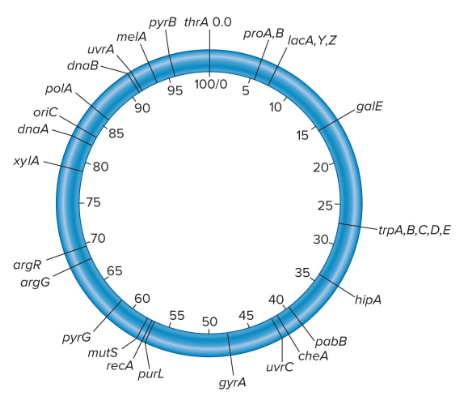
1) Mixed together a large number of Hfr donor and F- recipient cells
2) After different periods of time, take a sample of cells and interrupt conjugation in a blender
3) Plate the cells on solid growth medium lacking threonine and leucine but containing streptomycin.
4) From each surviving colony (all recipient cells) taken at different times, which should be positive for threonine and leucine and resistant to streptomycin, test if they are sensitive to the various conditions conferred by the remaining testable genes.
5) Construct a genetic map based on the times in which the genes appeared during conjugation
Wollman and Jacob used an Hfr and F- strain that had opposite genotypes for seven different genes. They already knew that the genes coding for threonine and leucine in Hfr were transferred first in that order. They proposed that by interrupting conjugation at various times, they could determine the order of the remaining genes in the Hfr chromosome as it is transferred to the F- strain. All genes except that encoding for streptomycine resistance (strr) was tested (streptomycin was used to kill the Hfr donor cells after conjugation while the recipient cells were resistant and coded for this gene). What steps did they take to conduct this experiment?
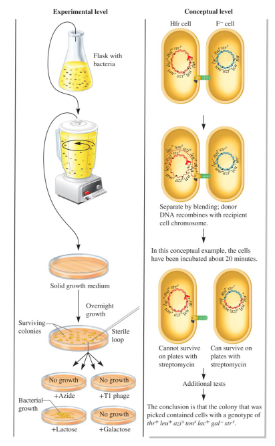
1) A genetic map of six genes that either conferred sensitivity to certain agents or ability to synthesize different amino acids in E.coli.
2) Identified various Hfr strains in which the origin of transfer had been integrated at different places in the chromosome.
3) Demonstrated that the E.coli chromosome was circular based on a comparison of the order of genes among these strains.
What did Wollman and Jacob discover from their interrupted conjugation experiment?
1) P22 → infect Salmonella
2) P1 →infect E.coli
What are two types of bacteriophages that can transfer bacterial DNA?
Natural Transformation
Bacterial transformation in which DNA uptake occurs naturally.
Artificial Transformation
Bacterial transformation in which DNA uptake occurs with the help of experimental techniques.
Common techniques include treating cells with calcium chloride and a high temperature shock, which makes cells permeable to small DNA molecules. Electroporation can also make cells permeable with external electrical field.
Competent Cells
Bacterial cells that are able to take up DNA. They carry genes that encode proteins called competence factors, which facilitate the binding, uptake, and incorporation of the DNA into the bacterial chromosome.
1) Extracellular endonuclease cuts the extracellular DNA into smaller fragments; one strand is degraded while a single strand is transported into the cell.
2) Homologous recombination can occur while the DNA is incorporated into the chromosome.
3) The heteroduplex, which is a region of mismatch caused by sequence differences between the two alleles, is repaired by DNA repair enzymes.
What are the steps of transformation?
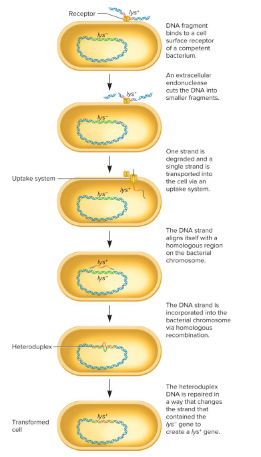
Nonhomologous Recombination
When the DNA that enters the cell during transformation is not homologous to any genes on the chromosome and is incorporated at a random site on the chromosome.
Homologous Recombination
The process by which transformed DNA that is homologous to a region in the bacterial chromosome is incorporated into the chromosome.
1) Competence-stimulating peptide - leads to competence only when many cells of the same species are nearby
2) DNA uptake signal sequences - DNA with this sequence is preferentially taken up
What are two structures or sequences used by bacteria to uptake transformated DNA only from dead bacteria or the same or similar species?
Horizontal Gene Transfer
The process in which an organism receives genes from another organism without being direct offspring. This can occur between and within species. The types of genes acquired through this can confer antibiotic resistance, which allow bacteria to breakdown the antibiotic, pump it out of the cell, or block its inhibiting effects.
Ex) Conjugation, transformation, and transduction.